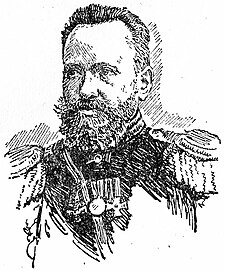Sergei Ivanovich Mosin
Sergei Ivanovich Mosin | |
|---|---|
 | |
| Born | Sergei Ivanovich Mosin April 14, 1849 |
| Died | February 8, 1902 (aged 52) |
| Occupation(s) | weapons designer, engineer |
| Spouse | Varvara Nikolayevna Arsenyeva |
| Website | http://www.aif.ru/society/science/33227 |
Sergei Ivanovich Mosin (Russian: Серге́й Ива́нович Мо́син, Apr 2 or 14, 1849 - February 8, 1902) was a Russian military officer, engineer, and a designer of the Mosin–Nagant rifle.[1]
Early life
Mosin was born in Ramon, in the Voronezh Governorate of the Russian Empire in 1849. He entered into a military academy at age 12 where he excelled as a young officer. In 1867, he entered the Alexandrovskoye Military High School in Moscow. Upon leaving Alexandrovskoye in 1870, he decided to go to the artillery branch and transferred to the Mikhailovskoye Artillery Academy. He graduated in 1875 and transferred to the Tula Arsenal where he became the head of the machining division.[1]
Mosin–Nagant
It was at Tula where Mosin began his career as a weapons designer by first making improvements to the Berdan II and later collaborating with Nagant to design the Rifle of Three Lines of the Year 1891.[2] Mosin eventually rose to the rank of General and was appointed as the director of the Sestroretsk arsenal.[3] He died on February 8, 1902 and was buried in Sestroretskoye Cemetery in St. Petersburg Sestroretsk.[4]
See also
References
- ^ a b Aleksandr Mikhaĭlovich Prokhorov, ed. (1973). Great Soviet encyclopedia. Vol. 17 (3 ed.). Macmillan. p. 181.
- ^ Wood, J. B. (2003). The Gun Digest Book of Firearms Assembly/Disassembly: Part 4 Centerfire Rifles. Vol. 4 (2 ed.). Iola, Wisconsin: Krause Publications. p. 383. ISBN 978-0-87349-631-5.
- ^ Barker, A. J.; John Walter (1971). Russian infantry weapons of World War II; Illustrated histories of twentieth century arms. Arco Pub. Co. p. 15.
- ^ [1]
